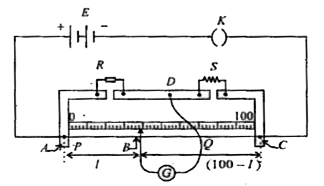With the help of a circuit diagram, explain how a meter bridge can be used to find the unknown resistance of a given wire.
A meter bridge is a practical form of wheatstone bridge. It consists of a wire AC of constantan or manganin of 1 metre length and uniform cross-sectional area. This wire is stretched between the copper strips on a horizontal wooden board. A metre scale is fixed on the wooden board parallel to the length of the wire. A resistance box R is connected as shown in the figure. An unknown resistance S is also connected. A jockey is slided on the wire. One terminal of the jockey is connected to the galvanometer and another terminal is connected to terminal D.
First close the key K and adjust the value of resistance box for a suitable resistance R. Move the jockey on wire till the galvanometer gives zero deflection. Note the length AB. Let AB=I. Also note the length BC=100−I of the wire.
Now, according to the wheatstone bridge principle PQ=RS
Where P= resistance of the length I of the wire =Ir
Q= resistance of the length (100−l)of the wire =(100−I)r
r= resistance per unit length of the wire
∴Ir(100−I)r=(R)(S)⇒S=(100−II)×R

Similar Questions
With the help of circuit diagram, explain how a meter bridge can be used to find unknown resistance of a given wire?
View SolutionWrite the principle of working of a potentiometer. Describe briefly, with the help of a circuit diagram, how a potentiometer is used to determine the internal resistance of a given cell.
View SolutionWrite the principle of working of a potentiometer. Describe briefly, with the help of a circuit diagram, how a potentiometer is used to determine the internal resistance of a cell.
View SolutionA meter bridge cannot be used to measure …… resistances
View SolutionExplain the use of a metre bridge for finding unknown resistance.
View SolutionDraw a circuit diagram of a meter bridge used to determine the unknown resistance R of a given wire. Hence derive the expression for R in terms of the known resistance S.
View SolutionWith the help of a circuit diagram, explain the working principle of metre bridge. How is it used to determine the unknown resistance of a given wire ? Write the necessary precautions to minimise error in the result.
View SolutionWith the help of a circuit diagram, explain the working principle of a metre bridge. How is it used to determine the unknown resistance of a given wire? Write the necessary precautions to minimise the error in the result?
View SolutionThe internal resistance of a cell by potentiometer is given by
View SolutionResistance of a wire is, measured using a meter bridge and the balancing length for the unknown resistance of 10ω in the right gap is 48 cm. Find the value of the resistance. If the end corrections are 0.6 cm and 0.4 cm respectively for the left and right ends, find the corrected value of the unknown resistance.
View Solution
